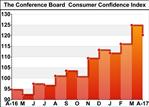
After reporting notable increases in U.S. consumer confidence over the two previous months, the Conference Board released a report on Tuesday showing that consumer confidence pulled back by more than expected in the month of April.
The Conference Board said its consumer confidence index fell to 120.3 in April from a revised 124.9 in March. Economists had expected the index to dip to 123.1 from the 125.6 originally reported for the previous month.
"Consumer confidence declined in April after increasing sharply over the past two months, but still remains at strong levels," said Lynn Franco, Director of Economic Indicators at The Conference Board.
She added, "Despite April's decline, consumers remain confident that the economy will continue to expand in the months ahead."
The report said the present situation index dropped to 140.6 in April from 143.9 in March, as consumers' assessment of current conditions eased.
Consumers saying business conditions are "good" declined to 30.2 percent from 32.4 percent, while those saying business conditions are "bad" edged up to 13.8 percent from 13.1 percent.
The Conference Board also said consumers' assessment of the labor market was moderately less favorable, as those saying jobs are "plentiful" declined to 30.8 percent from 31.8 percent.
Consumers were also less optimistic about the short-term outlook, with the expectations index sliding to 106.7 in April from 112.3 in March.
The percentage of consumers expecting business conditions to improve over the next six months decreased to 24.8 percent from 26.9 percent, while those expecting business conditions to worsen rose to 10.9 percent from 8.5 percent.
by RTT Staff Writer
For comments and feedback: editorial@rttnews.com
Economic News
What parts of the world are seeing the best (and worst) economic performances lately? Click here to check out our Econ Scorecard and find out! See up-to-the-moment rankings for the best and worst performers in GDP, unemployment rate, inflation and much more.

